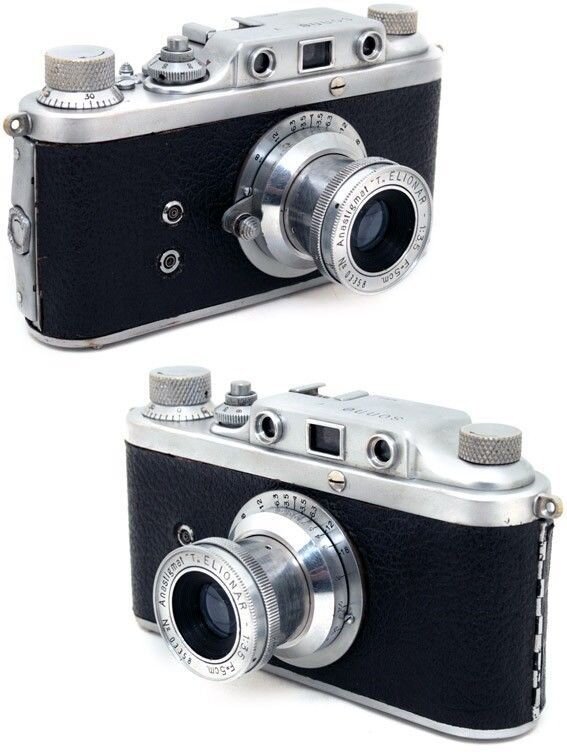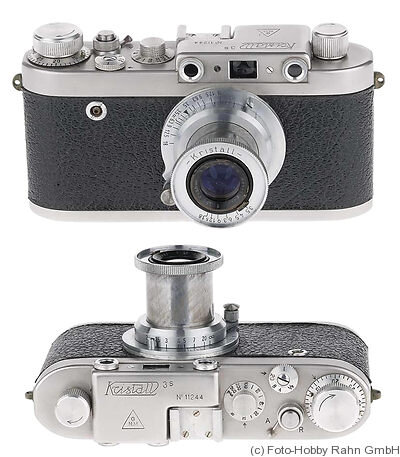Viva Italia: Rare Italian Leica copies of the 1950s
Italy isn’t the first country that comes to mind when you think of high precision cameras. While the combination of Italian engineering and craftsmanship has produced some of the world’s finest cars, motorcycles, airplanes, bicycles, and espresso machines, there is no Italian camera equivalent to, say, the Ferrari or Lamborghini. However, when it comes to creating fascinating Leica copies that run the gamut from simple and elemental to ingenious and sophisticated the Italians were surprisingly prolific. They clearly fell in love with the classic screw-mount Leica, and as the country slowly emerged from the ashes of World War II small Italian camera makers unleashed a dazzling variety of Leica-like creations, all aimed at satisfying the pent-up demand.
Let’s start with one of my favorites, the Janua, made by San Giorgio in Genoa Italy around 1949. Superbly constructed and finished, this very rare idiosyncratic model features a very long base combined range/viewfinder with dioptric adjustment (+/- 3 diopters) on the eyepiece, a built-in film cutter and extinction meter (see long horizontal window below the viewfinder window), an exposure calculation dial on the back, and a horizontal cloth focal-plane shutter controlled by a large diameter top-mounted dial providing speeds of 1-1/1000 sec plus B. The film advance knob and concentric, manually set frame counter are pure Leica II/III, as is the film loading system that requires removing the camera baseplate, but oddly the shutter release itself doubled as the rewind release!
Janua Italian Leica copy with built-in extinction meter
The Janua’s gorgeous collapsible 50mm f/3.5 San Giorgio Essegi lens sure looks like a clone of the 50mm f/3.5 Elmar but one reference source plainly states that it’s “fitted with a special bayonet mount.” This doesn’t make much sense to me unless there was (a futuristic concept at the time!) a screw-thread-to-bayonet adapter that let you mount LTM lenses. In any event while the original Janua has a cold shoe and no flash sync terminal, the latter was added on later Janua S models, and the factory would retrofit flash sync to earlier models on request. While the Janua lacks the consummate elegance and integration of form of the classic Leica it’s a very attractive camera and a brilliant piece of engineering. Apparently only a few thousand Janua and Janua S cameras were made over the course of its production, and today (surprise, surprise they’re costly and coveted collectibles. The Gamma (made by Gamma Officine Meccaniche de Precisione in Rome) was another audacious Leica inspired Italian rangefinder 35 that hewed more closely to the Leica III concept, with separate rangefinder and viewfinder windows and a short base, high magnification coupled rangefinder. However its shutter, an early metal focal plane, was a radical departure, consisting of “two curved aluminum curtains, each of which has a curved tooth rack that engages with a spring-loaded pinion that is adjustable to adjust the traverse speeds.” As the Leica the curtain travel speeds are fixed, and the actual shutter speeds are determined by the slit widths between the curtains. The slow speeds are controlled by a separate escapement and engaged by means of a lever under the fast speed dial, which you set to an asterisk mark to obtain the fast speeds. The first model, oddly dubbed the Gamma II, had a bayonet mount (what is it with these Italians!) a Leica style rangefinder, no slow speeds, and a Leica III style frame counter placed concentrically below the wind knob. The most common model, the Gamma III had a Leica compatible screw mount and an exposure counter window below the film wind knob. Shutter speeds range from 1-1/1000 sec plus B on models with slow speeds. The lens on the Gamma III shown is a collapsible 50mm f/3.5 Filotecnica-Milano Beta of unknown construction, but obviously inspired by the 50mm f/3.5 Elmar. The Gamma II was sometimes fitted with a 50mm f/2.9 Angenieux Type Z5.
Gamma III Italian Leica copy
Gamma, founded by Ireneo Rossi, worked with the lens maker Koristka, and later with Officine Galileo (maker of Condor rangefinder 35s and the elegant subminiature Gami), both of which were located in Milan. The company ceased camera manufacture in 1957 or 1958 but these innovative and beautiful rangefinder cameras are a testament to their enduring legacy.
The Wega cameras, basically Leica II copies, are well known among Leica collectors and prized for their elegant simplicity. They were made by AFIOM in Pordenone, Italy in the early ‘50s and were shown at the Milan Fair in 1953. The original Wega was a simple scale focusing model with an optical viewfinder, a cloth focal plane shutter with speeds of 1/20-1/1000 sec plus B set on a single top-mounted dial, a PC flash contact on the front, and a removable baseplate on the bottom for film loading. Conceptually it was very much like an updated Leica Standard, with Leica-like rounded ends and sporting a collapsible 50mm f/3.5 Wega Anastigmat lens which bears a close resemblance to the equivalent Elmar. Around 1952 AFIOM brought forth the Wega IIa a coupled rangefinder 35 that is functionally the same as a real Leica II but strangely has angled ends like an old rangefinder Canon. There was also a Wega IIIa, which is similar to the IIa except for a restyled shutter speed dial and what looks like a variable sync delay control like a Leica IIIf. Dario Mondaco who’s done extensive research on AFION and Wegas, estimates that about 2500-3000 Wegas (all types) were made over the course of their production, which ceased sometime in the late ‘50s. Wegas are lovely, expensive, and rather rare but they seem to command somewhat lower prices than the Janua or Gamma.
Wega front view showing LTM threaded mount and rangefinder coupling
Wega Italian Leica copy
Practically down the street from AFIOM in Belluno, Italy, Domenico Chinaglia made another series if Leica II copies that bear more than a passing resemblance to the Wega. They were sold under the name Kristall, the earliest examples being offered by Guido Nomini of Milan. The very first Kristall was strangely dubbed the 2a, and it had (what else?) a separate rangefinder and viewfinder, a focal-plane shutter with speeds of 1/20-1/1000 sec plus B, flash sync via a PC socket (except on the earliest models), and a Leica compatible screw mount. The Kristall 2s is virtually identical except for having a top shutter speed of 1/500 sec, and the Kristall 3s has shutter speeds of 1-1/1000 sec plus B, with the slow speeds set on a small adjacent dial atop the camera. Later 3s models have a rounded “shaped” top.
Kristall Leica copy cameras, 2 types c.1951-52 courtesy Collectiblend
There was also a rangefinder-less Kristall, known simply as the Kristall, or as the Kristall Standard to differentiate it from the rangefinder models. It was basically an interchangeable lens screw mount viewfinder camera in the tradition of the Leica Standard, but it also had angled rather than rounded ends like….a Wega! Since Chinaglia took over AFIOM (which was in operation until at least 1956) it is possible that he reissued his onetime competitor’s products under his own name.
Another brace of charming takeoffs on the Leica Standard C or E were the Elettra I and II made by SIRIO Firenze, an obscure and ephemeral company based in Florence, just after World War II, The Elletra I of c.1945 was a beautifully proportioned, black finished totally mechanical camera with rounded ends, a small screwed on optical finder, and sporting a 50mm f/8 Semitelar lens and a simple 3-bladed leaf shutter with 4 timed speeds from 1/25-1/200 sec plus T. In 1946 at the Milan Fair SIRIO launched the upgraded Elettra II in chrome finish with the finder fully integrated into the aluminum body, more modern wind and rewind knobs, and a classier looking 4cm f/5.6 Sculptor or 5cm f/4.5 Mizar lens. Call me an unabashed traditionalist, but I prefer the elemental Spartan look of the Elettra I.
Sirio Firenze Elettra I Leica IStandard copy
1946 SIRIO Elettra II
The second rarest Italian Leica copy ever? That would be the Recta, a rangefinder camera that looks (to me) like a superlative replica of a Leica IIIa. Designed by Telemaco Corsi a Roman lawyer and industrialist, the Recta has a focal plane shutter with a top speed of 1/1000 sec and a 39mm Leica screw mount. Corsi’s best-known camera design was the acclaimed Rectaflex 35mm SLR of the late ‘40s, and he evolved an impressive variety of improved Rectaflexes during the ‘50s. Sadly only 6 Rectas were produced bearing serial numbers 1001 to 1006. The only one I’ve ever seen was in a picture posted online by a Russian auction house but it can’t be copied, so no image. Sorry.
What’s the very rarest Italian Leica copy, you ask? Easy, that would be the exquisite and elusive Borletti, said to be the only one of its kind ever made. Even its excellent 50mm f/2 Galileo Eptamitar lens has no name engraved on the identification ring! It’s made almost entirely of stainless steel that has a characteristic subtle yellowish tinge that typical of its era—c.1949-1950. I’ll think I’ll console myself by running a roll of Tri-X through the Leica IIIc that inspired it.




